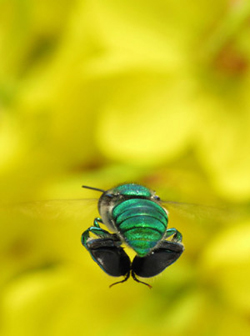Fragrances and speciation in orchid bees |
||
Perhaps mutations in the olfactory system of orchid bees can drive speciation. Scent-perception of males and females could be affected by the same mutation, e.g. in an olfactory receptor gene, changing both male trait (accumulated fragrance phenotype) and female preference (for the male frgarance phenotype) alike (Eltz et al. 2008). Assortative mating of olfactory morphs could theoretically lead to population divergence even in sympatry. We found evidence for olfactory differentiation in sympatric populations of two sibling species of Euglossa in southern Mexico (previously believed to be a single species, Euglossa viridissima). GC/MS analyses of hind leg extracts showed bimodal variation in male fragrance phenotypes, mostly based on the presence/absence of a single diagnostic compound (HNDB). The differences of fragrance phenotypes corresponded with population genetic markers. Population divergence may have been be driven by olfactory differentiation with respect to the mentioned diagnostic compound: Males that collect/contain HNDB exhibited significantly larger responses to it in electroantennogram (EAG) tests, while showing identical responses to all other tested stimuli (Eltz et al. 2008). Based on morphological, chemical, and genetic data the tridentate, HNDB-collecting lineage was descried as a new species, Euglossa dilemma Bembé & Eltz (Eltz et al. 2011). It happens that the populations of metallic green orchid bees that have recently become naturalized in Florida belong to the newly described species, E. dilemma. Further research explored perfume variation, population genomics, and the divergence of odorant receptor genes in the two sibling species along geographic and habitat gradients in southern Mexico (Brand et al. 2015, 2020). Eltz, T., Zimmermann, Y., Pfeiffer, C., Ramírez Pech, J., Twele, R., Francke, W., Quezada-Euan, J.J.G., Lunau, K. (2008): An olfactory shift is associated with male perfume differentiation and species divergence in orchid bees. Current Biology 18, 1844-1848. PDF Eltz T., Fritzsch F., Ramírez Pech J., Zimmermann Y., Ramírez S. R., Quezada-Euan J. J. G. & Bembé B. (2011) Characterization of the orchid bee Euglossa viridissima (Apidae: Euglossini) and a new cryptic sibling species by morphological, chemical, and genetic characters. Zoological Journal of the Linnean Society 163: 1064–1076. PDF Brand, P., Ramirez, S.R., Leese, F., Quezada-Euan, J.G., Tollrian, R. & Eltz, T. (2015) Rapid evolution of chemosensory receptor genes in a pair of sibling species of orchid bees (Apidae: Euglossini). BMC Evol Biol 15: 176. Brand, P., Hinojosa-Díaz, I.A., Ayala, R., Daigle, M., Yurrita Obiols, C.L., Eltz, T. & Ramírez, S.R. (2020) The evolution of sexual signaling is linked to odorant receptor tuning in perfume-collecting orchid bees. Nature Communications 11: 244. |
|
RUB » Dekanat für Biologie und Biotechnologie » Evolutionsökologie und Biodiversität der Tiere - Mitarbeiterhomepage PD Dr. Th. Eltz


